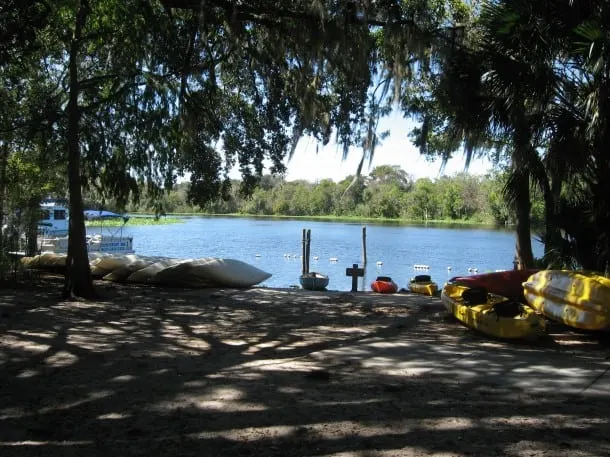Florida is blessed with hundreds of crystal clear springs, representing the highest concentration of freshwater springs on Earth.
Many, like Blue Spring, an hour north of Orlando, have been set aside for public use and to protect habitat for wildlife that depend on them for survival.
Blue Spring State Park is on the eastern edge of a vast basin of preserves, state parks and wildlife refuges that make up the watershed of the north-flowing St. John’s River in southwestern Volusia County.

It’s an exceptional place: The clear spring water has attracted more manatees in one place than anywhere else in the world — a record 932 manatees on a cold Jan. 21, 2023! (That’s pretty much wall-to-wall manatees.)
But this is a park for all seasons. When the manatees leave in spring, Blue Spring opens to swimmers and folks in tubes who go with the flow of the refreshingly cool water surrounded by a green shangrila.
Then, for a few magical weeks in late March and early April, the woods at Blue Spring State Park twinkle with fireflies, a display people get in line to see. (More below)
Year round, the park is a good launch site for kayaks, canoes and SUPs that can explore the backwaters of the St. Johns. Similarly, all year bicyclists will find a shady path in the adjoining paved Spring to Spring Trail.
You can make the park your temporary home, too, by reserving one of its 51 campsites or six cabins.
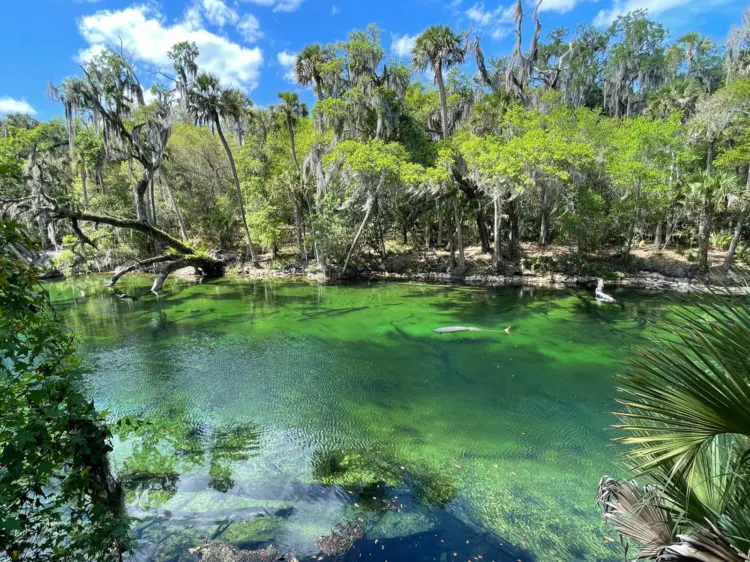
Viewing Blue Spring and manatees
When I visited Blue Spring, I thought it was actually green. But no matter its color, the clear water of the spring is magnificent. At 72 degrees year around, it is warm for manatees in the winter and cool for swimmers in the summer. About 100 million gallons of water flow from the spring into the St. Johns River every day, making it one of 33 first magnitude springs in Florida.
While manatees may swim in the spring any day of the year, they are most reliably seen from Nov. 15 to March 15. To see manatees, visit when the temperature is or has been cold. January is your best bet.
One thing that makes Blue Spring special is the half-mile-long boardwalk along the spring run, with its many overlooks that allow visitors to gaze into the water. Even without manatees, you’ll see huge gar, schools of fish, anhingas and cormorants and alligators along the spring run.
Blue Spring is home to one of the world’s most important manatee research programs. The U.S. Geological Survey Sirenia Project photographs and identifies manatees by their scar patterns to determine which manatees are returning to Blue Spring each year and construct manatee family trees.
The Save the Manatee Club non-profit operates webcams at the park and during manatee season, it posts updates on the number of manatees and the names of any manatees present who have been sponsored.
By the way: conservation efforts have had a dramatic impact. In 1970, researchers tracked only 14 manatees in the spring run that winter.
Swimming, tubing, diving at the beautiful spring
Note: There will be no swimming in Blue Spring State Park in the summer of 2024. All water activities are suspended for the season because of work on the docks and habitat restoration.
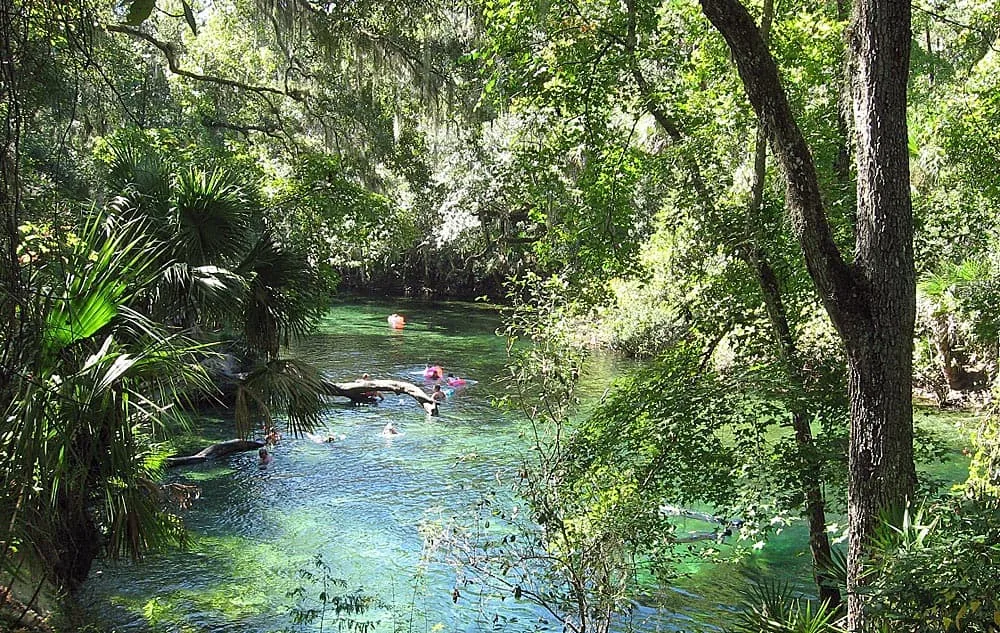
During the summer months, humans converge on Blue Spring en masse to enjoy the cool spring and its chilly, quarter-mile run to the river.
A fabulous swimming hole with multiple access points from a boardwalk that also allows you to hike through the woods along the run to the spring itself.
You can rent tubes or get a snack at the concession stand along the boardwalk.
Swimmers carry their tubes up the boardwalk to an entry point just below the spring. The takeout is a quarter-mile downstream.
Scuba divers must register at the entrance to the park and provide proof of up-to-date certification, and you must have a partner. (For a guided scuba experience, see Florida Dive Company.)
Get there early during summer or you could get locked out, especially on weekends. Saturdays and Sundays on hot, sunny days often see capacity crowds.
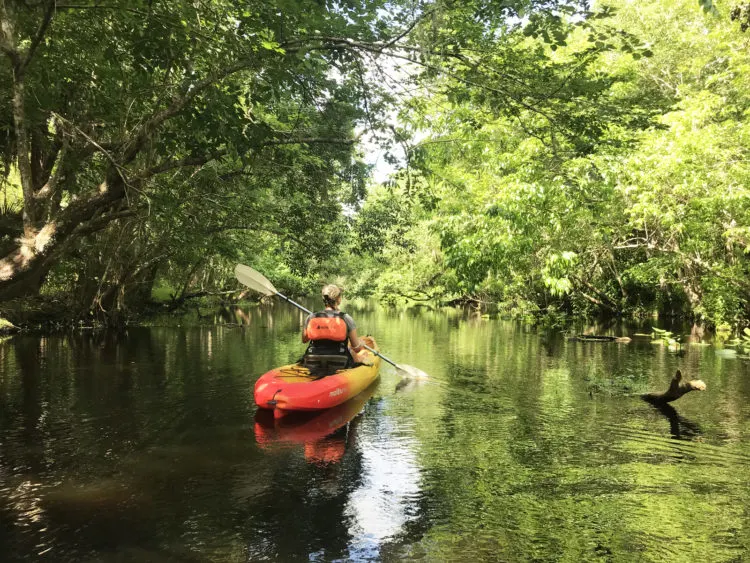
Canoes and kayaks at Blue Spring State Park
Blue Spring Run and the St. John’s River provide an outstanding wilderness environment for paddling.
You can rent kayaks, canoes and SUPs from the park concessionaire, Blue Spring Adventures.
Blue Spring Adventures has strict rules about where you can paddle. We had hoped to rent kayaks to paddle up the very scenic and wildlife-filled Snake Creek, a St. Johns tributary close to Blue Spring State Park where we had paddled in the past.
We were told, however, that we could only paddle “15 minutes” up Snake Creek because the concessionaire keeps all boats close enough for rescues.
We adapted and instead paddled close to the park for about three hours, along both the St. Johns and one of its oxbow islands and up Snake Creek a short a distance. The wildlife and scenery was splendid.
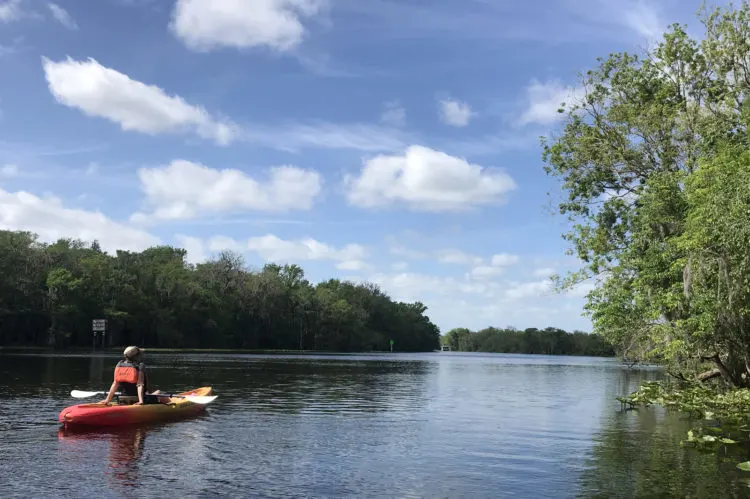
The highlight: The loud growling bellow of alligators in a marshy area around the oxbow island, a sign that spring mating season had begun.
For a longer paddle, we do recommend Snake Creek and if you don’t bring your own kayak, you can arrange to rent kayaks from other outfitters in the area.
The adventurous can paddle upriver to Hontoon Island State Park, where you’ll find 40 boat slips for boat campers. (Camping and cabins have not reopened since flooding in 2022.)
There’s also a terrific and challenging loop trail here, the 10-mile long Hontoon Dead River Paddling Trail, which we have paddled from Hontoon in the past. You’ll see more about it in our Hontoon Island State Park story.
Don’t want to kayak? Here’s a boat tour alternative to kayaking: The concessionaire at Blue Spring State Park also operates a tour boat that will take you out on the river tour with a guide. The guides here know their stuff — early one morning, unasked, the tour-boat naturalist pointed out to us the bald eagle in a tree across the water. He knew the three trees where that eagle pair are usually spotted.
Camping and cabins at Blue Spring State Park
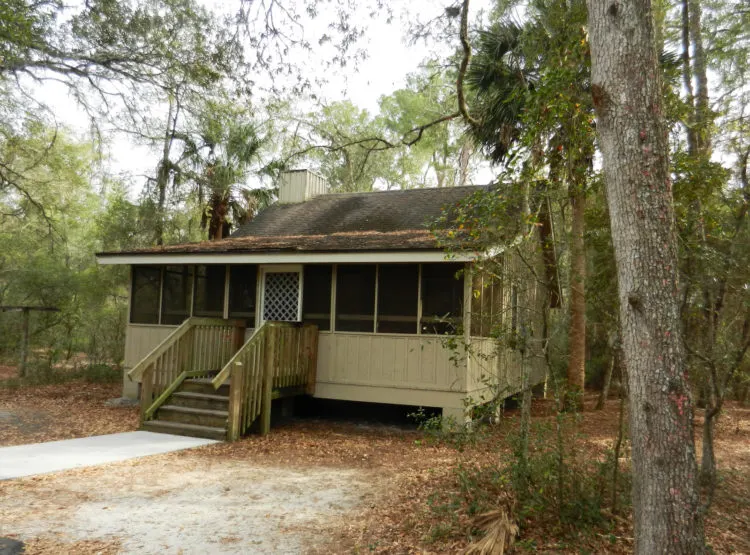
There are only six two-bedroom cabins at the state park, so plan head to reserve. At $95 a night, the cabins are terrific, nestled in a shady grove of oaks. One bedroom has a double bed and the other has twin singles. (The only downside: The mattresses are hard and uncomfortable.) There is also a sleeper sofa in the living room that converts to a double bed.
Each cabin has central air, a gas fireplace for use only in winter, a bathroom, a kitchen, a screened porch and outdoor grill with a picnic table. (If you are staying in the cabins and planning any real cooking, bring everything you might need or plan to make do. There wasn’t even a bowl for tossing a salad or a large frying pan.)
The campground gets positive but mixed reviews. Located in a scrub oak/palmetto forest, there are not extensive shade trees. The vegetation provides good screening between campsites, however, providing privacy.
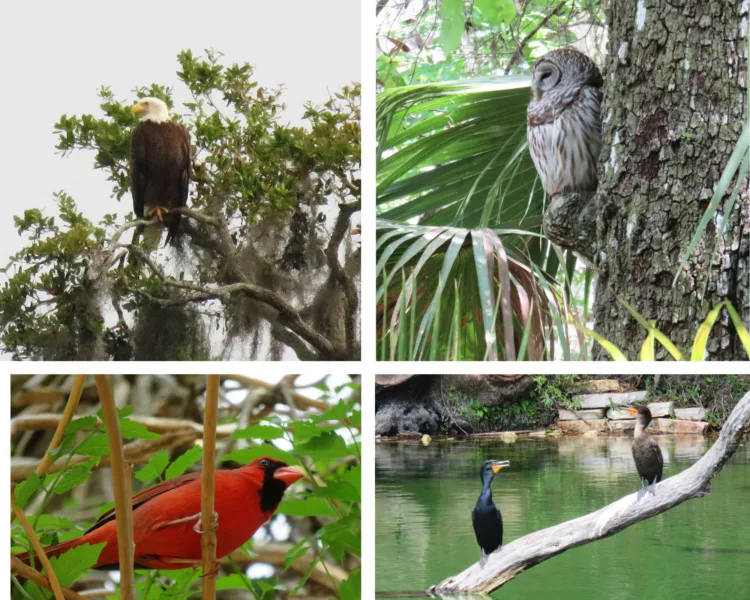
There are 51 campsites, $24 per night, and six two-bedroom cabins, which rent for $95 per night. A $6.70 reservation fee applies to each booking.
Each of the 51 campsites has water and electric hookups, a picnic table and a grill. There are no sewer hookups, although there is a dump station available to campers in the park. Pets are allowed in the camping area. Maximum RV length is 40 feet.
The campground is near the spring, and a path that will take you there.
More about Blue Spring State Park
Camping reservations can be made up to 11 months in advance online at reserve.floridastateparks.org or by calling 800-326-3521 or TDD 888-433-0287. For day of arrival bookings, call the ranger station directly at 904-794-0997.
To reserve a cabin: Go to reserve.floridastateparks.org or call 1-800-326-3521, Monday-Friday, from 8 a.m. until 8 p.m. up to 11 months in advance. (TDD 888-433-0287) Minimum stay is two nights. Maximum stay is 14 days.
Cabin Fees: In addition to the $95 base rate, campers will pay state and local taxes, a $6.70 booking fee and a new $7/day utilities fee for cabins with water and/or electric power.
Cancellations and changes: Cabin cancellation fee is $17.50, up until the day before the reservation begins. If you cancel on the first day of your reservation, you will also sacrifice your first night’s fees. Cancellations are not permitted within 18 days of making the reservation. Any other changes to your reservation will cost $10.
Pets: Not allowed in state park cabins or cabin areas. They are allowed in campgrounds.
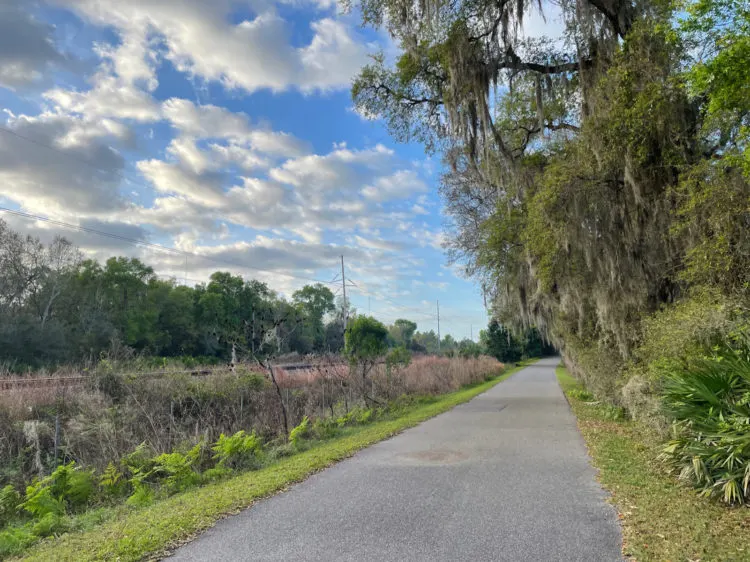
Biking at Blue Spring State Park
Thanks to a completed 5.5 mile segment of the Spring to Spring rail trail, Blue Spring State Park is now a great place to bring your bicycles. The 11-mile round-trip route is a gem — no intersections to cross and a paved shaded pathway through beautiful woods all the way to Lake Beresford Park, where you’ll find restrooms, picnic tables and hiking trails. It would make a great day if you’re visiting the Blue Spring area.
Embedded below is the Blue Spring segment of the trail and here’s a link to a map of the entire Spring to Spring trail
2022-3-spring-to-spring-blue-spring-segementHiking at Blue Spring State Park
The 3.6-mile Pine Island Trail passes through pine flatwoods and a marsh (wear boots in summer) and an oak hammock with four primitive campsites. (It is not a loop; so that 3.6 miles is one way.) It follows the perimeter of the park. The nature trail has signage about the different habitats.
The first section passes through a beautiful live oak forest with lots of shade. Soon the trail enters a shade-less sandy scrub habitat, which is a good place to spot the Florida scrub jay, a bright blue bird found only in Florida. Scrub jays are known for being smart, curious and friendly. (Note: It is illegal to feed them.)
History of Blue Spring State Park region
Blue Spring was an important steamboat landing along the St. John’s River, dating back to the mid-19th Century. The boats would load agricultural goods and tourists at the landing for transport “down” the St. John’s to Jacksonville and beyond.
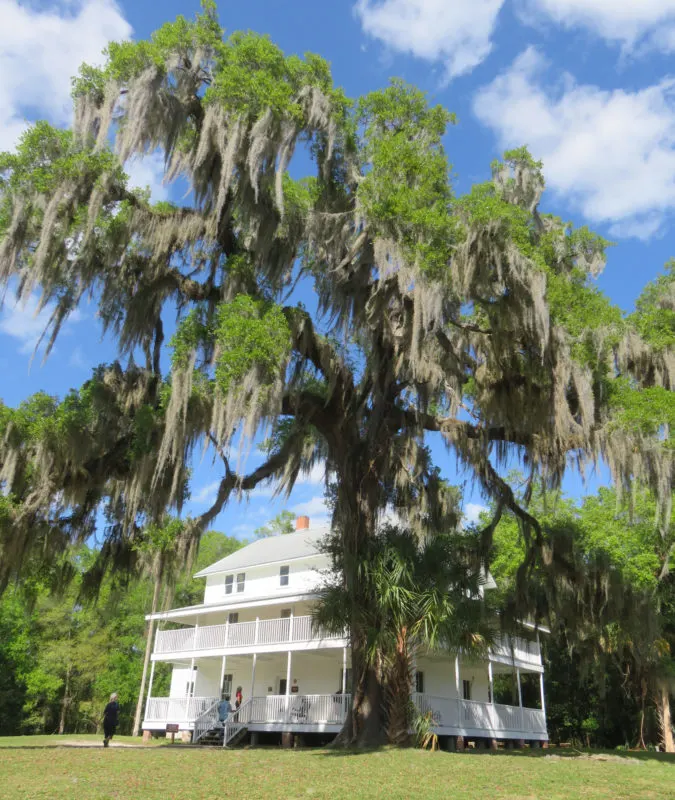
You can see evidence at the historic Thursby House, built at the height of the steamboat era in 1872 by settler Louis B. Thursby, who also built the landing.
The state didn’t take it over until the late 1960s, and faced a daunting task to clean up after visitors had abused the spring, driving their cars and parking on the banks, littering and dumping garbage in the woods.
Opportunities for touring the house are limited to groups and special events.
Firefly season at Blue Spring State Park
Every year, Blue Spring State Park lets visitors stay one hour after the traditional sunset closing time during firefly season to see “Mother Nature’s light show.”
In 2023, firefly viewing at the park was held for two weeks, encompassing three weekends, beginning March 17 and continuing through April 2. Every year, the exact dates are adjusted to reflect the schedule of the fireflies, which is determined by weather, but this is roughly the annual window.
The park admits a limited number of cars each night, so it is suggested you arrive early — 5:30 or 6 p.m. — because this is very popular. There is $6 per carload park admission, plus a $14 per car donation to the Friends of Blue Spring State Park, who provide volunteers along the self-guided trail.
The fireflies become visible as the skies darken and are at their most dramatic between 8 and 9 p..m., when you must leave the park.
Rambler tip: Come early, bring a picnic dinner and watch sunset over the St. Johns while you wait for darkness.
Here’s more about firefly season at Blue Spring State Park.
Blue Spring State Park
2100 West French Ave., Orange City, FL 32763.
Phone: 386-775-3663.
Hours: Open from 8 a.m. until sundown, 365 days a year.
Day use admission $6 per vehicle, $2 for pedestrians, bicycles.
Blue Spring State Park map and brochure
FAQs about Blue Spring State Park
Where is Blue Spring State Park?
If you drive through Orange City, you’d barely know Blue Spring State Park is there. Watch closely for signs, and then turn off U.S. 17 onto two-lane West French Avenue, which takes you through a typical suburban neighborhood until you reach the park entrance.
Take Interstate 4 to exit 114 (State Road 472) and follow the signs to U.S. 17/92.
Go a little more than two miles south on 17/92 to the traffic light at French Ave.
Turn right and go two miles through a neighborhood of modest homes to Blue Spring State Park.
If you are going to launch your own boat, you can continue past the park entrance on a shell rock road to the free boat launch at the end of the road on the St. John’s River.
How many manatees are in Blue Spring State Park?
It depends what time of year it is. In the summer, there are usually none. On cold winter days, there are hundreds. The record was Jan. 21, 2023, when there were 932 manatees in the spring. A month earlier, when weather was balmy, there were about 100 manatees in the spring. Here’s where to get the latest report on manatees in spring.
For more about seeing manatees read: Best places to see manatees in Florida
What temperature is Blue Spring?
The water stays 72 degrees year around. In the winter, the St. Johns River, into which it flows, gets much colder, as low the 50s.
What are the hours at Blue Spring State Park?
The park is open from 8 a.m. until sundown, 365 days a year. During firefly season (usually mid-March to mid-April, depending weather that year) the park allows visitors to stay to stay until 9 p.m. to enjoy the phenomenon.
Places near Blue Spring State Park and related links
Cabins at Blue Spring and three other Central Florida parks
Wekiva River Basin inviting to paddlers, campers
Hontoon Island: Camping, cabins, great kayak trip in wild setting
Best places to see manatees in Florida
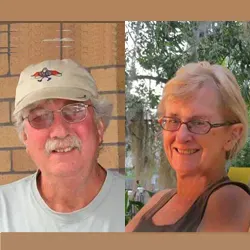
Veteran journalists who worked together at Fort Lauderdale’s SunSentinel newspaper, Bonnie and Bob founded FloridaRambler.com in 2010 to explore the natural, authentic Florida, writing about their natural interests in hiking, biking, paddling, RV and tent camping, wildlife, unique lodging, dining and historic places.

